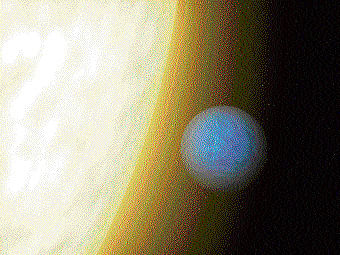
ASTRONOMY Spitzer Space Telescope has recently spotted light from alien planet 55 Cancri e, which orbits a star 41 light-years from earth. The James Webb Space Telescope, scheduled to launch in 2018, will be able to learn even more about the planet's composition, writes Mohan Krishna S A
National Aeronautical and Space Administration (NASA) has detected light from a super-earth for the first time. Super-earths are planets that are larger than our own but lighter than giant planets like Neptune — have been discovered before through indirect measurements, but the planet 55 Cancri e is the first to have its infrared light measured directly.
It’s also the smallest planet to have its brightness measured directly.
Light from an alien super-earth twice the size of our own earth has been detected by a NASA space telescope for the first time in what astronomers are calling a historic achievement.
NASA’s infrared Spitzer Space Telescope spotted light from the alien planet 55 Cancri e, which orbits a star 41 light-years from earth.
The planet was discovered in 2004 and is not a habitable world. It is known as a super-earth because of its size: It is about twice the width of earth and is super-dense, with about eight times the mass of earth. It is an extrasolar planet with half the mass of Neptune orbiting the sun.
Its mass is about 7.8 earth masses, thus classifying it as the first super-earth discovered around a main sequence star, predating Gliese 876 d by a year.
Spitzer’s view of the 55 Cancri e is the first time light from a rocky super-earth type planet has been seen.
Since the discovery of 55 Cancri e, astronomers have pinned down increasingly strange features about the planet. Researchers already knew it was part of an alien solar system containing five exoplanets centered on the star 55 Cancri in the constellation Cancer. The new Spitzer observations revealed that the star-facing side of 55 Cancri e is extremely hot, with temperatures reaching up to 3,140 degrees Fahrenheit (1,726 degrees Celsius).
Past observations of the planet by the Spitzer Space Telescope have suggested that one-fifth of 55 Cancri e is made up of lighter elements, including water. But the extreme temperatures and pressures on 55 Cancri e would create what scientists call a “supercritical fluid” state.
Studying habitable worlds
The spacecraft is pioneering the study of atmospheres of distant planets and paving the way for NASA’s upcoming James Webb Space Telescope to apply a similar technique on potentially habitable planets.
The planet, called 55 Cancri e, falls into a class of planets termed super earths, which are more massive than the earth, but lighter than giant planets like Neptune. Previously, Spitzer and other telescopes were able to study the planet by analysing how the light from 55 Cancri changed as the planet passed in front of the star.
In the new study, Spitzer measured how much infrared light comes from the planet itself.
The results reveal the planet is likely dark, and its sun-facing side is more than 2,000 Kelvin (3,140 degrees Fahrenheit), hot enough to melt metal.
Like the majority of known extrasolar, 55 Cancri e was discovered by detecting variations in its star’s radial velocity. At the time of its discovery, three other planets were known to be orbiting the star.
The same measurements were used to confirm the existence of the uncertain planet 55 Cancri c. A limitation of the radial velocity method used to detect 55 Cancri e is that only a minimum mass can be obtained, in this case around 7.8 times that of earth, or 48% of the mass of Neptune.
Earth’s close neighbour
The 55 Cancri system is relatively close to earth, 41 light-years away. It has five planets, with 55 Cancri e the closest to the star and tidally locked, so one side always faces the star. Spitzer discovered the sun-facing side is extremely hot, indicating the planet probably does not have a substantial atmosphere to carry the sun’s heat to the unlit side.
NASA’s James Webb Space Telescope, scheduled to launch in 2018, will be able to learn even more about the planet's composition. The telescope might be able to use a similar infrared method to Spitzer to search other potentially habitable planets for signs of molecules possibly related to life.
Supercritical fluids can be imagined as a gas in a liquid state, which can occur under extreme pressures and temperatures. On earth, water can become a supercritical fluid inside some steam engines. The previous studies of 55 Cancri e were performed by analysing how the light from its parent star changed as the planet passed in front of it, a technique known as the ‘transit method’.
In the new study, astronomers used the Spitzer Space Telescope to determine the infrared light from 55 Cancri e itself. Spitzer's new look at 55 Cancri e is consistent with supercritical-fluid theory.
The planet is likely a rocky world covered with water in a supercritical fluid state and topped off with a steam blanket. Using Spitzer, researchers measured the faint dip in brightness caused by 55 Cancri e passing in front of its star.
Since these so-called transits occur every 18 hours, scientists have plenty of opportunities to collect enough data to help them estimate the size, volume and density of the alien planet, agency officials said.
Based on these results, the researchers calculated that 55 Cancri e has a mass 7.8 times that of earth, and a width just over twice that of our planet.